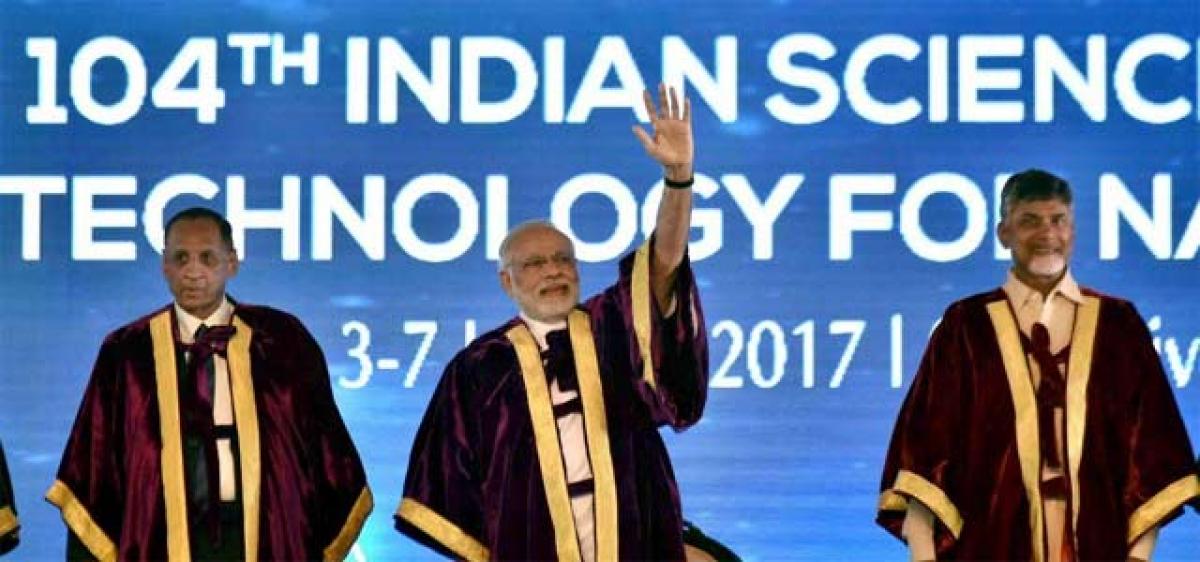Live
- A Guide to Temperature and Humidity Standards in Data Center Server Rooms
- Gadwal collector briefs on details of voters
- Jupally Krishna Rao takes part in Alampur rallu
- Bharath Prasad files 3rd Nomination
- Baisakh Month: A Time of Auspicious Beginnings and Sacred Festivals
- Oust BJD govt for overall development, says Shah
- Unveiling the Hidden Gems: Surprising Health Benefits of Garlic Peels
- Overcoming Sleep Struggles: A Comprehensive Guide to a Restful Night
- RTC bus hit the auto
- MLA Kuchukula Rajesh Reddy participated in the Birappa festival
Just In

Indian Science Congress celebrates the achievements in science and technology and rightly so. But a more serious appraisal of what ails Indian science is the need of the hour.
Indian Science Congress celebrates the achievements in science and technology and rightly so. But a more serious appraisal of what ails Indian science is the need of the hour.
Though the Nobel Prize is not the only criteria to assess the progress of science, it remains a fact that with meager resources, pre-independent Indian science could win a Nobel whereas the post-independent Indian science could not measure up to the challenge.
India’s science, technology and innovation system is plagued by multiple deficiencies and inadequacies. The global share of Indian publications is a mere 3.5 per cent that is unbecoming of an aspiring world economic leader. Our record in regard to acquiring patents is dismal despite lofty talk of innovation.
The Gross Expenditure on Research and Development (GERD) is less than one per cent of India’s GDP indicating a resource crunch. The allocations would be much more less when adjusted to inflation.
On the contrary, China spends 1.5 per cent of its GDP. China is investing at least five times more money in R&D compared to India due to its much higher GDP.
Despite benefitting from economic liberalisation, the ratio of private and public sector investments in R&D is 1:3. Even this meager spending is concentrated in few sectors like pharmaceuticals and automotives. The science and technology policy should focus on promoting a robust and diversified private sector spending.
On the other hand, the strategic sectors like defence gobble up a lion’s share of the public sector R&D expenditure revealing what Amartya Sen calls the social costs of militarisation.
Despite proliferation of institutions of higher education, most of them remained teaching centers with little or no research intensity.
The Reserve Bank of India (RBI) data suggests that foreign investment driven companies account for about 20 per cent of R&D expenditure in the private sector.
The fruits of this research would be under stringent intellectual property rights regime. India cannot have free access to it even though the research is done in this country.
The core human resource in science and technology is dismal in India as scientific research is no longer the preferred career option of youth in the country.
Besides such quantitative limitations, Indian science suffers from quality concerns too. The elitist biases in scientific research should be discouraged so as to encourage inclusive innovation through scientific and technological research.
The class room confined, examination oriented, syllabi specific and memory driven education system does not foster scientific inquiry among our young minds.
The governance structures in scientific institutions are beset with bureaucratic hangovers adversely affecting the research eco system.
As enunciated by the Science, Technology and Innovation Policy of 2013, science and technology for the people should be the new paradigm of Indian research enterprise.
This requires a symbiotic relationship between science and socio economic policies. Scientific research agenda should focus on finding affordable and inclusive solutions to the nations’ challenges in the fields like energy, food security, nutrition, affordable housing, health care, environment, water and sanitation and employment.

© 2024 Hyderabad Media House Limited/The Hans India. All rights reserved. Powered by hocalwire.com







